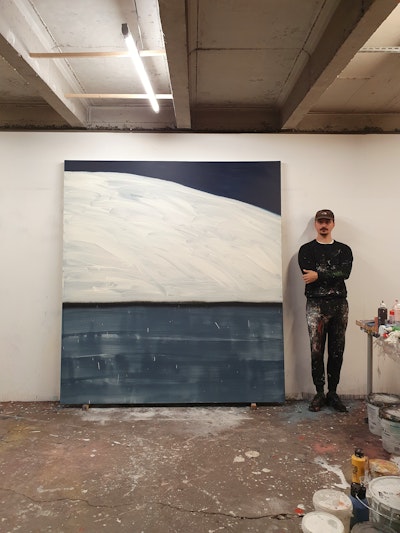Conversation in tandem with Tristan Paprocki (Galerie Romero Paprocki, Paris) and artist Lou Ros, led by Emanuela Mazzonis
Emanuela Mazzonis: Good morning Tristan Paprocki and Lou Ros, thank you for being with us today and for participating in this cycle of interviews held by the Luxembourg Art week and dedicated to a selection of galleries taking part in the fair for the first time. I would like to start asking Tristan to introduce Romero Paprocki gallery, founded in 2021 in Paris, the gallery exhibits emerging and recognized artists from the international contemporary art scene.
Tristan Paprocki: Hi Emanuela, thanks for having us. Guido Romero Pierini and I met during one of his most important exhibition back in 2020, « So Close » presenting 16 artists among which Lou Ros. We teamed up in 2021 to found Romero Paprocki and represent emerging contemporary artists. As for « So Close », we choosed a museum-scale space in order to match the quality of the works presented there. For the gallery, settings are a the supports of a given discourse, which highlight the artist’s work and his thought altogether, the revelation of a form, its dialogue, meaning-making and articulation. The gallery has to be a unique time-space, conducive to thinking and contemplation, to exchanges as much as introspection to formulate a discourse serving of art. After a year of research, the gallery opened is first space this October in Le Marais, Paris.
EM: Lou, you started doing graffiti at the age of 16 in the streets of Paris, then you moved on to a more figurative painting (I think of your portraits and bird series) but at the same time abstract (in this case I refer to the series of landscapes). Looking to the latter series, the paintings seem to be divided in half by an horizon line that detaches the evanescent spots of color, I see a strong reference to Mark Rothko (the expansion of the color that emerges from the edges of the canvas) and the Color Field Painting. About your technique, is quite vast, you use a lot of acrylic, but also spray, pastel and a little quantity of oil. Would you like to tell us about your artistic training and how you came to your current style?
Lou Ros: When I started working, I admired Francis Bacon and Cecily Brown, which prompted me to work a lot on human figures. I think I got a little focused on these theme, and lately, I aimed to pay to another type of living being that humans have been crushing for many decades: nature and birds, which I loved to observe and discover as a child. After working for so long on figurative subjects, I focused on the most efficient way to represent landscapes. When talking about simplified landscapes, one must obviously be aware of the Color Field Painting movement. The works of Helen Frankenthaler, Etel Adnan or Robert Motherwell are essential for me. In my landscapes I try to flirt with the limit of abstraction by avoiding specifying architecture and human presence. not defining architecture or human presence. In doing so, I avoid temporality. What's more, the texture of the the spray paint has become like a kinf of signature and allows me to distinguish heaven and earth.
EM: The internet giants (the GAFA Big Four - Google, Apple, Facebook and Amazon - that I named in the title of this conversation) are now an integral part of our life and our habits. We are controlled, spied on, almost monopolized by the Big Four but at the same time we cannot live without them. We use the resources that these digital “monsters” provide us on a daily basis and I would say obsessively. The same goes for the social media that fill our days and our habits. I turn to Lou as an artist and Tristan as a gallery owner to ask you how you respectively adapt to today's ultra-digital world. Are you afraid of it, in the sense that it could only become a risk for our identity, creativity and personality or do you have faith in the dynamic implications that this digital world could present to us in the near future?
TR: As a young gallery owner, I evolved from the beginning of my career with social networks and online exhibitions and sales. I believe these are essential tools to offer international visibility to young artists and young galleries. It also allows us to get in touch much more easily with foreign artists or new collectors.
LR: As an artist it is important to adapt. It is of course possible to have visibility without social networks, but to me the essence of human intelligence is its ability to adapt. We definitely have to be aware of this new reality without exagerating with enthousiasm.
EM: Finally, I would like to ask Tristan, who participates for the first time to the Luxembourg Art Week with his gallery, if he can anticipate with a short statement what the booth will look like at the fair.
TP: We will present a selection of the gallery’s artists to show the full extent of our artistic programming and give visibility to all. We'll go for one work per artist, with a mix of paintings and sculptures.

